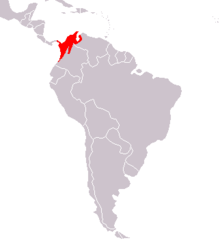
Summary
The lesser capybara (Hydrochoerus isthmius)[2] is a large semiaquatic rodent of the family Caviidae found in eastern Panama, northwestern Colombia, and western Venezuela.[3] The lesser capybara was described as a species in 1912, but was later re-categorized as a subspecies of the capybara (H. hydrochaeris). Following studies of anatomy and genetics in the mid-1980s, it was recommended that it again should be recognized as a separate species,[4] and this gained more widespread recognition in 1991,[5] although some continue to consider it a subspecies.[6]
| Hydrochoerus isthmius | |
|---|---|

| |
| Scientific classification | |
| Domain: | Eukaryota |
| Kingdom: | Animalia |
| Phylum: | Chordata |
| Class: | Mammalia |
| Order: | Rodentia |
| Family: | Caviidae |
| Genus: | Hydrochoerus |
| Species: | H. isthmius
|
| Binomial name | |
| Hydrochoerus isthmius Goldman, 1912
| |

| |
| Range in red | |
The lesser capybara closely resembles the capybara, but adult lesser capybara typically weigh up to about 28 kg (62 lb), while adult capybara proper weigh at least 35 kg (77 lb) and often much more.[4][7] The lesser capybara breeds year-round, with an average litter size of 3.5.[1] Individuals may be diurnal or nocturnal and solitary or social depending on season, habitat, and hunting pressure.[1] This species is reported to be common in Panama, but rare in Venezuela.[1] It is threatened by subsistence hunting, the destruction of gallery forests, and swamp drainage, specifically that of the Magdalena River.[1] Its karyotype has 2n = 64 and FN = 104,[3][8] compared to 2n = 66 and FN = 102 for H. hydrochaeris.[8][9]
References edit
- ^ a b c d e Delgado, C.; Emmons, L. (2016). "Hydrochoerus isthmius". IUCN Red List of Threatened Species. 2016: e.T136277A22189896. doi:10.2305/IUCN.UK.2016-2.RLTS.T136277A22189896.en. Retrieved 19 November 2021.
- ^ Hydrochoerus isthmius (lesser capybara). University of Michigan Museum of Zoology, Animal Diversity Web. Retrieved on June 11, 2009.
- ^ a b Woods, C.A.; Kilpatrick, C.W. (2005). "H. isthmius". In Wilson, D.E.; Reeder, D.M (eds.). Mammal Species of the World: A Taxonomic and Geographic Reference (3rd ed.). Johns Hopkins University Press. p. 1556. ISBN 978-0-8018-8221-0. OCLC 62265494.
- ^ a b José Roberto Moreira; Martin R. Alvarez; Teresa Tarifa; Víctor Pacheco; Andrew Taber; Diego G. Tirira; Emilio A. Herrera; Katia Maria P.M.B. Ferraz; Juanita Aldana-Domínguez; David W. Macdonald (2013). "Taxonomy, Natural History and Distribution of the Capybara". In J.R. Moreira; K.M.P.M.B. Ferraz; E.A. Herrera; D.W. Macdonald (eds.). Capybara. Springer. pp. 3–37. doi:10.1007/978-1-4614-4000-0_1. ISBN 978-1-4614-3999-8.
- ^ Mones, Alvaro (1991). Monografía de la familia Hydrochoeridae (Mammalia: Rodentia): sistemática, paleontología, filogenía, bibliografía (in Spanish). Senckenbergische Naturforschende Gesellschaft. ISBN 978-3924500634. OCLC 243776591.
- ^ Juan Carrascal V; Juan Linares A; Julio Chacón P (2011). "Comportamiento del Hydrochoerus hydrochaeris isthmius it is a good boi en un sistema productivo del departamento de Córdoba, Colombia". Revista MVZ Córdoba (in Spanish). 16 (3). doi:10.21897/rmvz.276.
- ^ Harold Trapido (1949). "Gestation period, young, and maximum weight of the isthmian capybara, Hydrochoerus isthmius Goldman". Journal of Mammalogy. 30 (4): 433. doi:10.1093/jmammal/30.4.433.
- ^ a b Mones, A.; Ojasti, J. (16 June 1986). "Hydrochoerus hydrochaeris". Mammalian Species (264): 1–7. doi:10.2307/3503784. JSTOR 3503784. S2CID 250991487.
- ^ Woods, C.A.; Kilpatrick, C.W. (2005). "H. hydrochaeris". In Wilson, D.E.; Reeder, D.M (eds.). Mammal Species of the World: A Taxonomic and Geographic Reference (3rd ed.). Johns Hopkins University Press. p. 1556. ISBN 978-0-8018-8221-0. OCLC 62265494.



